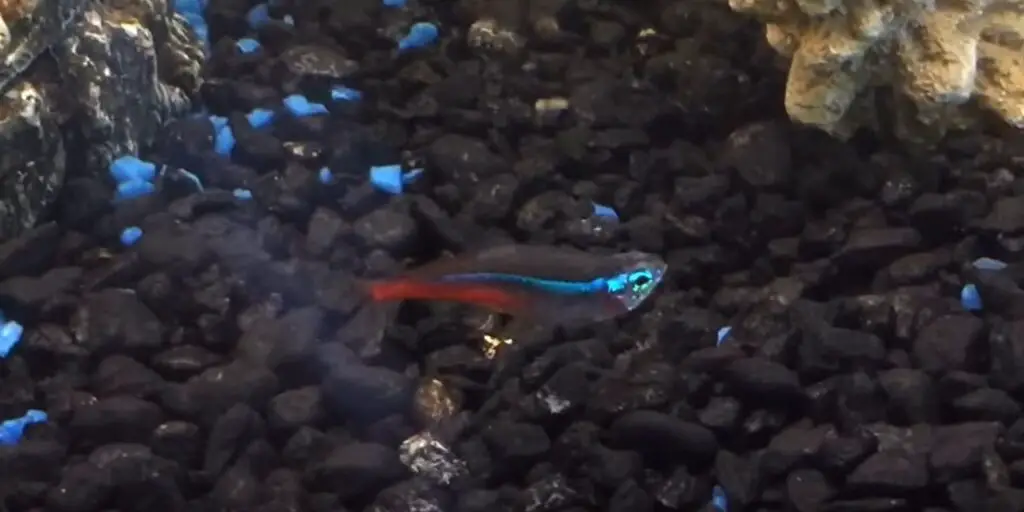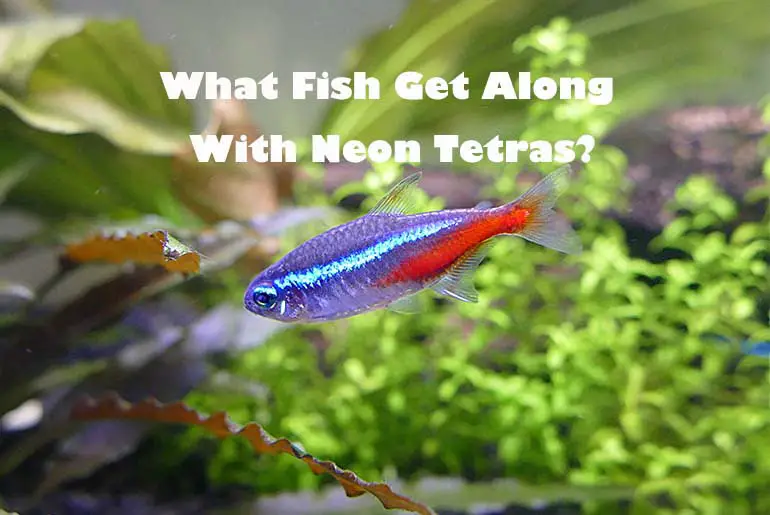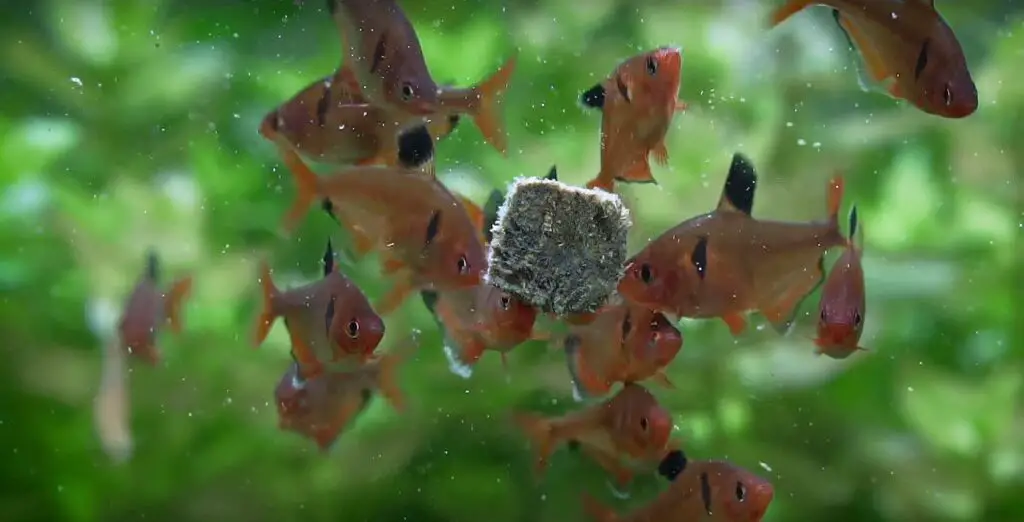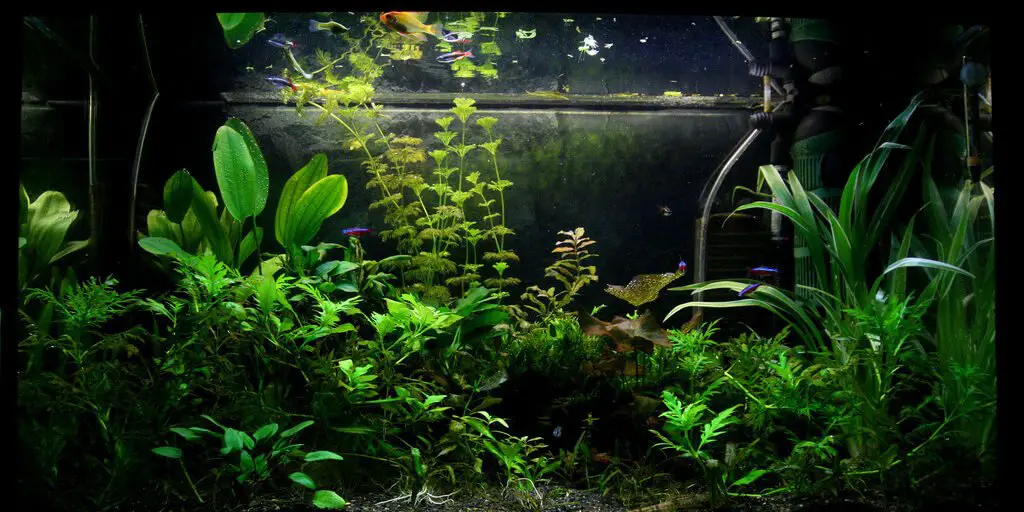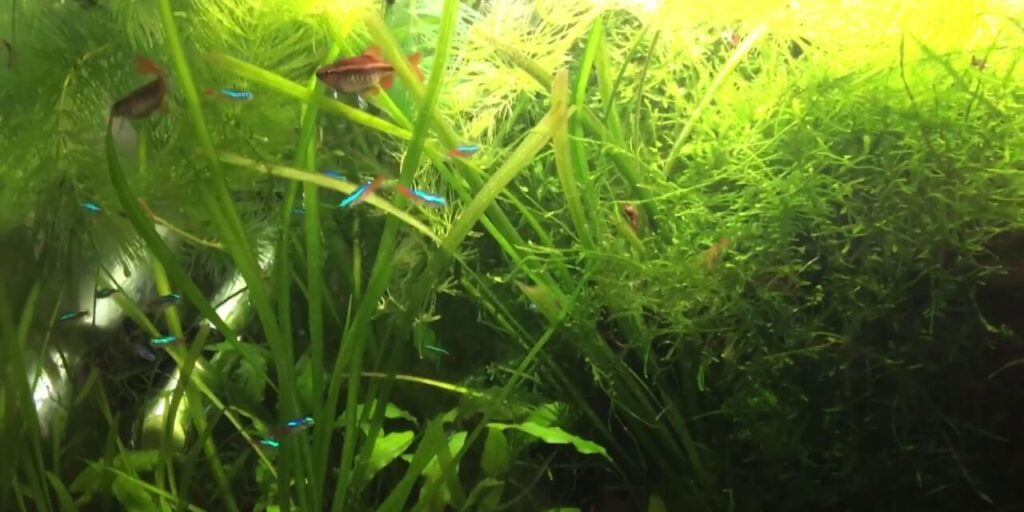Due to the vibrant color and non-aggressive nature Tetra are among the most popular fishes among fish keepers. Aquarist has categorized Tetra as a schooling fish because they prefer to live in a community. They are always recommended to be kept in a school of 10 to 15 fishes of the same kind. By nature, these fishes are tropical, i.e., they require a heated aquarium. The preferred aquarium temperature for tetra fish is about 21-27 Celsius. These fishes usually thrive in a planted environment. They produce a very small bioload, so the filter power required is quite low. The minimum tank size that a school of 15 tetras requires is about 10 gallons or 38 liters.
In the wild, our aquarium fishes have quite a long lifespan. But, due to some reasons, they can hardly live just up to half of their lifespan in the aquarium. The main reason for this is the disease. Some common diseases are fungus, dropsy, columnaris, hemorrhagic septicemia, etc. So, today I have come up with the most common Diseases that tetra fish suffer from, their symptoms and treatments.
Some common way to prevent your fishes from getting infected is
- Changing 10% of the water every week.
- Maintaining adequate temperature level, pH level.
- Using water test kits, filters, and heaters to meet the basic environmental needs of your fish.
Better Safe Than Sorry!
If you think your tank is only home to your fish, you are wrong. It contains several species of bacteria, parasites, and viruses that cannot be seen by our eyes. These creatures dwell on the feces of the fishes and dirty water, or dead fish bodies. So, cleaning your aquarium regularly means saying NO! to these harmful parasites. Some of these parasites cause such life-threatening diseases that you might have to say goodbye to many of your fishes at the same time. I had this experience once, and it was a heartbreaking moment. So, cleaning your filters sponge, removing 10% water weekly, and removing dead fishes if any, can help your fish live a longer life without getting any disease.
How to prevent fish from getting sick? Follow these steps.
- Make sure you have an extra tank to quarantine your fish.
- When you buy a new fish, quarantine them in your quarantine tank. You never know where your fish came from and with which type of fish they were kept with. So, after you buy your fish quarantine them for 1-2 weeks. If newly bought fish don’t get sick, you can add them to your main tank.
- Always buy fish from reliable sources.
- Make sure you have an optimal temperature, pH and hardness.
- Do weekly water change and check for ammonia and nitrate spikes.
- Check your fish compatibility with other fish before you keep them in tanks.
- Do your research. Just don’t go buy a fish you think will make your tank look great. Learn about them before you purchase them. Never purchase them and learn about them as you might be too late to even learn about them.
So what do you do when your fish get sick? Follow these steps.
First, identify the diseases. Note the symptoms and structure of the body. Compare with available symptoms and be sure what diseases it is.
- Move the infected/sick fish to a hospital tank to treat. Do a water change and vacuum in the main tank to reduce the change of other fish getting sick.
- Follow the medication procedure as recommended by the product. Don’t under or over doge the medication.
- Depending on the diseases, make sure to treat or change in the main tank as well.
- After recovery, keep it in a quarantine tank for a week or so to make sure it is completely healed. Once it is completely free from diseases, move it back to the main tank.
Common Reason For Your Tetra Fish To Fall Sick
Here are some of the reasons why your fish is/might/will be sick/dead
Stress
Stress is one of the major reasons why tetras get sick. It is slow and deadly. First, it weakens the immune system so various viruses, parasites or bacteria can attack the fish. Stress can come in the form of physical or chemical.
Physical
Tetras are small fish. Anything larger than the fish can stress them out. Not just large fish but fast swimmers as well. In case you have kept tetras with semi-aggressive or aggressive fish, they (aggressive fish) will hunt tetras.
It is just not only the fish, but surrounding can stress them as well. The absence of plants in the tank or high flow rate water can stress fish out.
Chemical
Ammonia, nitrate, pH, hardness, etc can also stress fish out. If ammonia and nitrate are in high amount, it will slowly stress fish out and ultimately kill it. Same for pH and hardness, if optimal pH and hardness aren’t present in your aquarium water.
Temperature
Temperature is also known to cause stress by temperature itself has its own category. Fluctuation in temperature stress fish out. This is the reason why we dip the fish bags in our aquarium for 20-30 min. By doing this, we are actually accumulating fish bag temperature to fish tank. If we were to put fish directly into the tank, if the bag’s temperature and tank’s temperature is different, the sudden change in temperature will stress fish out.
Another reason why temperature is important is that, in the case of high or low temperatures, which fish cannot tolerate, will die.
Dirty water
When I say dirty water, I mean foreign elements added to the tank. It can be unwashed sand, rock, decoration, hand, etc. When unwashed decoration or hand is entered into the water, we are increasing the chance of letting foreign elements enter into our tank by the high number. Foreign elements can be a virus to bacteria to toxic chemicals. You never know which fish is stressed out and because of your unhygienic habit; you let pathogens enter into the tank, you will increase the chance of fish getting sick. An example of toxic chemicals is soap. If you haven’t washed your hand properly, soap will kill your fish.
Neon Tetra Disease | The Deadliest One |Symptoms, Treatment and Prevention
The lifespan of Tetra fishes in an aquarium can be up to 5 years. However, they might die early due to various other reasons like illness, pH fluctuation in aquarium water, low temperature, etc. The most common disease in these fishes is Neon Tetra Disease (NTD). This fatal disease is named so because it was first seen in tetras, but nowadays, it can be seen in other breeds also. NTD is caused by a parasite called Pleistophora hyphessobryconis. The parasite enters the fish’s body through the consumption of dead infected fishes or infected live food. Then the parasite starts eating the fish from the inside. They also damage the muscle tissues in fish, which makes them weaker.
Symptoms of NTD
After the parasite has affected your fish, it will start showing significant or insignificant symptoms. Some of them are:
- Fishes show irregular swimming patterns and turn to bottom dwellers.
- Fish begins losing its color.
- The most common symptom is ich.
- You can see the cyst in their body.
- Fish acts Restlessness.
- You can notice a secondary infection such as bloating and fin rot.
During the initial phases, you might notice the fish staying away from the school. As the disease progresses, the muscle tissues around the spine start getting affected. This eventually leads to the curvature of the spine. Also, you can see the cyst on any part of the fish. The fish even starts showing secondary infections such as rotten fin and bloating, which are not directly linked to the disease itself.
Treatments
As soon as you see the symptoms mentioned above on your fish, you must take action right away. To be honest, the best and the only thing you can do is remove the infected fish and wait patiently if there are any other fish that show the same symptoms. Examine the tank carefully, and if you find no such fish with similar symptoms, quickly change the water. This is all you can do.
Preventions
Prevention is the only fight against NTD. You can take the necessary steps from an early time to prevent this disease. Almost 10% of the water must be changed weekly. You must use water test kits to test water conditions. Also, you must study the thermometer temperature and make changes accordingly. This disease has no cure at all. Your fish will be affected non-violently at the beginning, but later it will die. But you can prevent the spreading of the virus all over your tank through various measures. The phrase “PREVENTION IS BETTER THAN CURE” comes quite handy at this point.
As soon as you install the fishes into your tank, you must start acting wisely. This disease is highly contagious. So, you must remove infected fish or fishes instantaneously. Also, be sure that there are no dead fish, insects, or other beings lying around in any corner. Regularly check for symptoms. Also, avoid giving live food to your fishes. Before purchasing fishes from the store, observe them for some time; you can usually identify sick fish because it will not school with others. Do not buy infected fish. After buying fishes, do not immediately put them to your aquarium instead of quarantining them for few days in a separate tank. This not only helps prevent illness from spreading on your aquarium but also promotes new fish adjust in their new environment.
Some Common Tetra Fish Diseases and Treatments Guide
NTD is not only the diseases that can be seen in your fishes. There are infinitely many diseases that an aquatic animal can catch. Some of these diseases are discussed below, along with their symptoms, causes, and treatment.
Fin and Tail Rot
The disease tail rot or fin rot is quite common among aquarium fish. It starts with the edge of the fin, and gradually reaches the fin’s base. Goldfish and Betta fish are most vulnerable to this disease. However, due to poor water quality in your tetra tank, you tetra fish can also suffer from this disease.
Symptoms
- The primary and quite noticeable symptom is the de-coloration on the edge of the fin.
- Fraying of the fin or tail can also be seen.
- Fish also exhibit a loss of appetite. If left untreated, this can spread out to the whole body.
Treatments
- First Move your Fish to a Quarantine tank / Hospital Tank.
- Treat the water immediately and add fish antibiotics.
- If possible, add aquarium salt to the water to soothe the fish.
- Change 20 to 30 percent of the water every other day.
Columnaris
Columnaris is a symptom disease in fish caused by bacteria Flavobacterium columnare. It can be treated with antibiotics and prevented by proper tank management.
Symptoms
- The appearance of ulcers on the scales.
- Identifiable white or cloudy patches near the gills area.
- Fish will bread rapidly due to gill infection. Also, change in gills’ color can be seen.
Treatment
- You can add Antibiotics like Copper sulfate, Acriflavine, Furan and Terramycin to the tank.
- You can use Terramycin by adding it to the fish food for internal infections or use it to give fish a bath.
- Salt may be added to the water to reduce stress (1 to 2 tablespoon per gallon of water).
Hemorrhagic Septicemia
It is a deadly disease seen in fishes that are caused by the Piscine novirhabdovirus. It affects over 50 species of freshwater and is a deadly fish disease.
Symptoms
- This disease is internal; Hence most of the fish don’t show external symptoms, but you can see symptoms like the bloated abdomen, reddish eyes, gills, fins in some fishes.
- They might also show other abnormal behavior in swimming.
Treatment
- The best treatment is to clean the tank as quickly as possible.
- Since it is a slow disease, create a stress-free environment for the fish and let things slow down.
Dropsy
It is a disease caused by the build-up of fluid inside the fish body, causing swollen bellies. Dropsy is also known as bloating. It is exactly not a disease but rather a symptom of an underlying disease that your tetra fish is suffering from. This disease is caused by improper nutrition, a massive drop in temperature, stress from transportation, aggressive tankmates, etc.
Symptoms
- Reduction in appetite.
- Huge swollen bellies that drop-down grossly.
- Sometimes the curved spine can also be seen.
- Swimming near the surface.
- Pale Gills,
- Red/ swollen anus,
- fins clamped together
- Scales would stand out like a pinecone appearance.
Treatment
- Quarantine the infected tetra fish in a separate environment (Hospital Tank).
- Add salt to the water (one tablespoon per gallon of water).
- Treat the infected tetra fish with antibiotics via food or water.
Pop-Eye
It is also not a disease but a symptom of an underlying disease where one or both eye bulges out due to the fluid build-up either behind or in the eye. The eyes of the tetra fish suffering from this disease may appear cloudy or may even look clear in some cases.
Symptoms
- Swelling in either both or one eye can be seen.
- You can notice cloudy eyes.
Treatment
- Place the infected fish in a quarantine tank and use the traditional salt method.
- Maintain proper temperature and check pH value, ammonia nitrite level regularly.
- If any parasites cause it, then use necessary antibiotics.
- Feed the tetra fish high-quality foods to support healthy immune system.
Eye-Cloud / Cloudy Eyes
Fish can have cloudy eyes can due to various reasons. Some of them are old age, parasites, stress malnutrition, etc.
Symptoms
- ·The eye becomes cloudy almost to complete whiteness, and the fish might also lose vision.
Treatment
- You must treat the water immediately. You can add aquarium salts.
- As you fish suffer from disease due to poor water quality, you will need to maintain the water parameter in the hospital tank.
- Use the Freshwater Master Test Kit to monitor your aquarium water parameter and act accordingly.
Mouth Fungus
Mouth fungus is also called mouth rot. It is a bacterial infection caused by Flexibacter Columnaris or Flavobacterium Columnare. These bacteria feed on dead fish, food remains, and fish poop. If the aquarium is not clean enough, this bacteria can also affect the fish with the strongest immune system.
Symptoms
- Mold or cotton patch like structure is formed around the fish mouth.
- Less frequently, it shares the symptoms with Columnaris, resulting in spots on fins, gills, etc.
Treatment
- Antibiotics like kanamycin act well against mouth fungus.
- Antibacterial medications like phenoxyethanol and nifurpirinol are also known to do well
- The long term treatment, however, is to keep the water clean.
Furunculosis
Furunculosis is a serious, septicemia, a bacterial disease found principally in salmonid fishes, but it may also occur in goldfish and other cyprinids. It is a highly contagious disease.
Symptoms
- Fish shows lethargic swimming, loss of appetite, respiratory distress.
- The body gets darker, and gills become paler
- Hemorrhages on skin and fins.
Treatment
- Use iodine to prevent it from spreading to fertilized eggs.
- You can use the necessary medications that are available in stores locally.
Fish Fungus / Fungal Infection
Fungal infections can cause damage to various organs in fish, such as liver, kidney, etc. It occurs when your tetra fish is in a weak state or in some sort of trauma. A fish present in a poor living condition can also get a fungal infection.
Symptoms
- Light grey or cottony growths on skin, gills, fins, eyes.
- Bulging eyes, loss of colors, abnormal swimming nature(rare), ulcers.
Treatment
- Medicate the water with potassium permanganate.
- Raising the temperature of the water by a little bit, i.e., up to 30 degrees C, can help.
- Increase the salt level and calcium level in the tank.
Velvet
Velvet is a fish disease caused by dinoflagellate parasites that affect both marine and freshwater fish. This disease gives the infected fish a dusty, brownish-gold color. This disease occurs most commonly to tropical fish and also to marine animals in some rare cases.
Symptoms
- The tetra fish suffering from velvet will initially flash by rubbing itself against walls or any other objects.
- They will exhibit lethargy by clamping their fins very close to their body.
- A dusting of particles will be left all over the body if left untreated- colors ranging from brown to gold to green.
Treatment
- Table salt is very helpful in reducing velvet.
- Because velvet parasites gain some of their energy photosynthesis, leaving the aquarium in complete darkness for few ‘days’ can help solve the problem.
- Some people also prefer increasing the tank temperature in order to quicken the life cycle of the parasite.
White Spot Disease or ICH
Ichthyophthirius multifiliis is a freshwater parasite that causes the most common disease on fish called white spot disease or ich. It appears on the body, fins, gills as white salt like particles of up to 1 mm. Each white spot is a parasite.
Symptoms
- Loss of appetite and refusing almost all food.
- Fish tries avoiding school.
- Flashing and swimming abnormally.
- Fish become bottom dwellers.
Treatment
- You can add formalin or malachite green or a combination of both.
- Increasing temperature to about 30c can prevent replication.
- You can use aquarium salt, copper, methylene blue.
Anchor Worm
Lernaea, commonly known as anchor worms, are parasitic to freshwater fishes. The female worm after mating burrows inside a fish body and transforms worm-like form, usually with a portion sticking out from the fish body.
Symptoms
- Worms can be visible sticking out from the fish body.
- Inflammation of the body of the fish
- You can see a constant flashing can as the fish feels uneasiness.
Treatment
- The best way to treat anchor worm is by manually, i.e., by holding the fish gently and pulling the worm out carefully using tweezers.
- Potassium permanganate is usually the best treatment and can be both used as tank treatment or dip.
Fish Lice
Fish lice (Argulus spp; family Argulidae) are branchiuran crustaceans that affect both marine and freshwater fishes. They are not related to lice, which are insects. Fish lice are flat and oval-shaped, and we can visibly see them with our naked eye, sometimes even when they are inside the fish. They are one of the biggest parasites (5-10)mm.
Symptoms
- Fish with lice inside it will constantly flash and rub itself.
- The fish will behave restlessly.
- When inside the fish body, the lice can move anywhere freely, even to the gills, causing respiratory problems.
Treatment
- There is no way you can pull that thing out of a fish, hence using proper antibiotics and medications.
- After the lice are out, separate the fish in another aquarium and treat it with saltwater for soothing purpose.
Hole In The Head
Freshwater Head and Lateral Line Erosion (HITH), also known as a hole in the head disease, primarily affects freshwater fish. The primary cause of this disease is a parasite called Hexamita. This parasite first affects the intestine, liver, and kidney and finally leaves lesions on the head.
Symptoms
- Pitting type lesions on the head and lateral lines.
- You can see your fish having a loss of appetite, flashing, illness.
Treatment
- You must add antibiotic metronidazole to the tank containing the infected fish.
- You should give proper nutrition to fish through fresh frozen meaty food or vegetables.
Swim Bladder Disorder
Swim bladder disorder or flip over is a common disorder in aquarium fish. The swim bladder is a gas-filled bladder that helps to provide an upthrust to the floating fish, so it doesn’t sink. This can be caused by internal parasites, constipation, or high nitrate level from overfeeding.
Symptoms
- Fish floats nose down tail up, can float to the top or sink to the bottom.
- Floating upside down or on their side.
- Fish can’t maintain a proper position.
Treatment
- Sometimes the disorder can be caused by low temperature, so maintaining a temperature of about 20-30 C is important.
- Adding a small amount of aquarium salt can come in handy.
- Reducing the water level or water flow can help the fish become more steady.
Tumors
Fishes can get cancer or tumor just like humans. Most of them get a tumor due to genetic reasons. Others get a tumor due to a viral infection.
Symptoms
- You can see bumps or lumps under the fish’s skin.
- Tumor in gills causes the fish to be unable to close the gills.
- You can notice a loss of appetite and a problem in respiration in your fish.
- Tumor in reproductive organs causes swollen abdomens.
Treatment
- You have to euthanize most of the fish with a tumor because it has no cure.
- You can treat a fish with gill tumors by placing the fish in water medicated with iodine.
Gill Parasites
The main parasites that affect fish’s gills are Dactylogyrus and Neobenedenia.
Symptoms
- You can see swollen and pale gills as the fish has difficulty in respiration.
- The fish will try to remove the parasite by flashing, brushing and rubbing itself.
Treatment
- You must quarantine infected fish immediately.
- The water must be changed or treated with formalin and praziquantel.
Ammonia Poisoning
Ammonia Poisoning is the invisible fish killer. It occurs in a newly established tank or a tank where many fishes are added at the same time. It can also be caused if the filter fails suddenly, and bacterial colonies die off due to medicative changes.
Symptoms
- Fish might gasp at the surface for air.
- You can see red or purple gills.
- Fish becomes lethargic.
- Fish becomes a bottom dweller.
- Loss of appetite.
Treatment
- Lowering the pH level in the water provides relief.
- Change almost 50% of the water immediately.
- Use products that neutralize the ammonia.
Slime Disease
It is a parasitic infection that occurs as an overproduction of mucus coating. It is mainly caused by stress. Fishes stress out due to the poor water conditions, overcrowding, malnutrition, and low temperature.
Symptoms
- You can see a grey / white mucus coat wrapped around the fish.
- Irritation on the skin causes fish to flash and scratch themselves constantly.
- You can notice Lethargy and loss of appetite on fish.
- You can see secondary infections like fin rot on your fish.
Treatment
- Before beginning the treatment, change at least 30% of the water.
- Add anti-bacterial products like formalin.
- After the treatment, you must change 50% of the water to clear the medicine.
Conclusion
Now, I have discussed almost every disease that might affect your fish. Note that the treatment may vary from fish to fish, so consulting a vet is always the best option. But, after reading all this, you might have got the slightest of hint that taking preventive measures in your aquarium is always better than finding a cure or grieving at the death of your fish.
